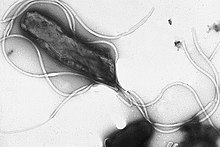H. pylori
| Helicobacter pylori | |
|---|---|
| staining of H. pylori from a gastric biopsy | |
| Pronunciation | |
| Classification and external resources | |
| Specialty | Infectious disease, gastroenterology |
| ICD-10 | B98.0 |
| ICD-9-CM | 041.86 |
| OMIM | 600263 |
| DiseasesDB | 5702 |
| MedlinePlus | 000229 |
| eMedicine | med/962 |
| Patient UK | Helicobacter pylori |
| MeSH | D016481 |
| Helicobacter pylori | |
|---|---|
 |
|
| Scientific classification | |
| Domain: | Bacteria |
| Phylum: | Proteobacteria |
| Class: | Epsilonproteobacteria |
| Order: | Campylobacterales |
| Family: | Helicobacteraceae |
| Genus: | Helicobacter |
| Species: | H. pylori |
| Binomial name | |
|
Helicobacter pylori (Marshall et al. 1985) Goodwin et al., 1989 |
|
Helicobacter pylori, previously Campylobacter pylori, is a gram-negative, microaerophilic bacterium found usually in the stomach. It was identified in 1982 by Australian scientists Barry Marshall and Robin Warren, who found that it was present in a person with chronic gastritis and gastric ulcers, conditions not previously believed to have a microbial cause. It is also linked to the development of duodenal ulcers and stomach cancer. However, over 80% of individuals infected with the bacterium are asymptomatic, and it may play an important role in the natural stomach ecology.
More than 50% of the world's population harbor H. pylori in their upper gastrointestinal tract. Infection is more prevalent in developing countries, and incidence is decreasing in Western countries. H. pylori's helical shape (from which the genus name derives) is thought to have evolved to penetrate the mucoid lining of the stomach.
Up to 85% of people infected with H. pylori never experience symptoms or complications.Acute infection may appear as an acute gastritis with abdominal pain (stomach ache) or nausea. Where this develops into chronic gastritis, the symptoms, if present, are often those of non-ulcer dyspepsia: stomach pains, nausea, bloating, belching, and sometimes vomiting or black stool.
...
Wikipedia
